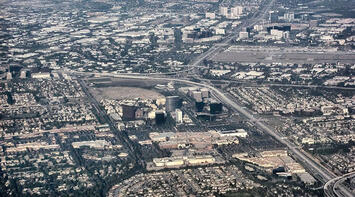
If there's one thing that really bothers me in urbanist circles, it's that there's no real agreed upon definition for what exactly is "urban". This is a fundamental problem, because it leads to differing sides always talking past each other, often using the same data to drive home vastly different points. Could astronomers and astro-physicists talk to each other if there were similar debates about what "space" is? I've been working on a development typology, based on my earlier "Big Theory" on American development, and it's time for us to stop being confused or misled about what's urban and what's not.
Take for example two recent pieces on city and suburban growth. Demographer William Frey of the Brookings Institute wrote last week about the recent trend of big city population growth rates exceeding that of suburban areas since 2010:
"On the positive side for urban boosters, the numbers show that many cities have gained more people in the three-plus years since the 2010 Census than they gained for the entire previous decade. This includes three of the five largest cities, New York, Philadelphia and Chicago (which lost population in the previous decade). Among the 25 largest cities, nine are already ahead of their previous decade’s gains, including Dallas, Denver, Memphis, San Francisco, San Jose and Washington, D.C. (See table)
Still another positive indicator for big cities is their growth rates. For each of the last three years, cities with populations exceeding 250,000 grew at rates exceeding 1 percent—far higher than their average annual rate of 0.49 percent over the 2000-2010 decade (Figure 1). Among the fastest growing, with rates exceeding 2 percent are Seattle, Austin, Charlotte, Denver and Washington D.C., each with new knowledge based economies and high amenity downtowns."
Yet demographer Wendell Cox writes at New Geography that the recent trend is an isolated event, and that Americans are clear in their preferences for a suburban built environment:
"On a percentage basis, the historical core municipalities of the 52 major metropolitan areas (more than 1,000,000 population) managed to grow 3.4 percent between 2010 and 2013, more than the suburban rate of 3.1 percent. This is probably the first time this has occurred in any three year period since the end of World War II.
But the core municipalities now contain such a small share of major metropolitan area population that the suburbs have continued to add population at about three times the numbers of the core municipalities (Figure 2). Indeed, if the respective 2010-2013 annual growth rates were to prevail for the next century, the core municipalities would house only 28.0 percent of the major metropolitan area population in 2113 (up from 26.4 percent in 2013)."
Here's how I see it. Irrespective of local political boundaries, most people recognize three types of development patterns in America -- pre-urban (mostly areas platted and developed before 1860 and relatively scarce), urban (platted and developed between roughly 1870-1935, and often linked to transportation networks), and suburban (platted and developed after 1945, and generally car-oriented). I connect the pre-urban, urban and suburban periods with the three development eras I've come up with since the formation of our nation -- the mercantile era, the industrial era, and the auto era.
Read the rest of this piece at The Corner Side Yard.
Pete Saunders is a writer and researcher whose work focuses on urbanism and public policy. Pete has been the editor/publisher of the Corner Side Yard, an urbanist blog, since 2012. Pete is also an urban affairs contributor to Forbes Magazine's online platform. Pete's writings have been published widely in traditional and internet media outlets, including the feature article in the December 2018 issue of Planning Magazine. Pete has more than twenty years' experience in planning, economic development, and community development, with stops in the public, private and non-profit sectors. He lives in Chicago.
Photo: aerial view of Irvine, looking south. John Wayne airport runway is shown at center right of the image. Source: Wikimedia












